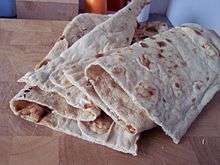Pathiri
|
Pathiri | |
| Alternative names | Ari pathil, pathil |
|---|---|
| Place of origin | India |
| Region or state | Kerala |
| Main ingredients | Rice flour |
| Variations | Neypathiri, poricha pathiri, meen pathiri, irachi pathiri |
|
| |
Pathiri (Malayalam: പത്തിരി, pronounced [patː̪iɾi]) is a pancake made of rice flour. It is part of the local cuisine among the Mappilas of North Malabar and Malabar in Kerala State of Southern India. Crushed rice is made into a white dough and baked on pans called oadu. After preparation it is sometimes soaked in coconut milk to keep it soft and to improve the flavor.
Pathiri is also known as ari pathil or pathil in some parts of the Malabar region. The word pathiri traces its origin to the Arabic word fateerah فطيرة, meaning "pastry". It is believed that{{by whom?}} pathiri itself originated with the Arabs in Malabar.
Today, pathiri is still a popular dish among the Muslims in Kerala.[1] It is usually prepared for dinner and served with meat or fish. In some regions, pathiri is regularly served during Iftar in the Muslim fasting month of Ramadan.
Variants of pathiri include neypathiri (made with ghee), poricha pathiri (fried rather than baked), meen pathiri (stuffed with fish), and irachi pathiri (stuffed with meat).
Irachi pathiri
Irachi pathiri or Irachi pathil is very popular in North Malabar and is a very common snack in areas of Thalassery, Vatakara and Malappuram. It is made in the same way as a samosa, but the only difference is that the outer skin in which the masala is stuffed is made of wheat flour. In some places all-purpose flour is used for the skin. It is made by stuffing a masala made of cooked chicken or meat, which is shredded to very small pieces using bare hands and then adding onion, green chillies, garlic turmeric and a little chili powder and heating until onions are brown in very little ghee over a medium flame, then stuffing in the already prepared skin and frying in oil. It is the size of the samosas which are common in Northern India. Unlike samosas though, the skins are not roasted. It is a main item on the Iftar menu in the Malabar area, along with other items such as unnakkayi and Chatti Pathiri.
See also
- Kinnathappam
- Kalathappam
- Alsa
- Cuisine of Kerala
- Arab Influence on Kerala: Malik ibn Dinar
- List of Indian breads
References
- ↑ Moideen, Cini P. (12 June 2015). "Rice pathiri, Ari pathiri, Kerala Malabar pathiri". CheenaChatti. Retrieved 9 July 2015.
External links
![]() Media related to Pathiri at Wikimedia Commons
Media related to Pathiri at Wikimedia Commons

